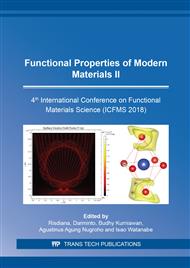[1]
T. Tietze, P. Audehm, Y-C. Chen, G. Schütz, B.B. Straumal, S.G. Protasova, A. Mazilkin, P.B. Straumal, T. Prokscha, H. Kuetkens, Z. Salman, A. Suter, B. Baretzky, K. Fink, W. Wenzel, D. Danilov, E. Goering, Interfacial dominated ferromagnetism in nanograined ZnO: a μSR and DFT study, Sci. Rep. 5: 8871 (2015) 1-6.
DOI: 10.1038/srep08871
Google Scholar
[2]
A. Zorko, P. Jegličnik, D. Arčon, A. Balčytis, Z. Jagličić, X. Liu, A.L. Tchougréeff, R. Dronskowski, Unconventional magnetism in a nitrogen-containing analog of cupric oxide, Phys. Rev. Lett. 107 (2011) 047208 1-4.
DOI: 10.1103/physrevlett.107.047208
Google Scholar
[3]
A. Zorko, F. Bert, P. Mendels, K. Marty, P. Bordet, Ground state of the easy-axis rare-earth Kagome langasite Pr3Ga5SiO14, Phys. Rev. Lett. 104 (2010) 057202 1-4.
DOI: 10.1103/physrevlett.104.057202
Google Scholar
[4]
I. Watanabe, T. Adachi, S. Yairi, Y. Koike, K. Nagamine, Change of the dynamics of internal fields in the normal state of La2-xSrxCuO4, J. Phys. Soc. Jpn. 77 (2008) 124716 1-6.
DOI: 10.1143/jpsj.77.124716
Google Scholar
[5]
K.M. Kojima, Spin gap systems: what can be measured by muon spin relaxation? Appl. Magn. Reson. 13 (1997) 111-122.
DOI: 10.1007/bf03161974
Google Scholar
[6]
D.H. Ryan, J. van Lierop, J.M. Cadogan, Zero-field muon spin relaxation studies of frustrated magnets: physics and analysis issues, J. Phys.: Condens. Matter 16 (2004) S4619-S4638.
DOI: 10.1088/0953-8984/16/40/012
Google Scholar
[7]
M.R. Crook, R. Cywinski, Voigtian Kubo-Toyabe muon spin relaxation, J. Phys: Condens. Matter 9 (1997) 1149-1158.
DOI: 10.1088/0953-8984/9/5/018
Google Scholar
[8]
M.I. Larkin, Y. Fudamoto, I.M. Gat, A. Kinkhabwala, K.M. Kojima, G.M. Luke, J. Merrin, B. Nachumi, Y.J. Uemura, M. Azuma, T. Saito, M. Takano, Phys. Rev. Lett. 85 (2000) 1982-1985.
DOI: 10.1016/s0921-4526(00)00337-9
Google Scholar
[9]
T. Yamazaki, Ryogo Kubo and μSR , Hyperfine Interaction 104 (1997) 3-13.
Google Scholar
[10]
R. Kubo, A stochastic theory of spin relaxation, Hyperfine Interaction 8 (1981) 731-738.
Google Scholar
[11]
M.I. Larkin, Y. Fudamoto, I.M. Gat, A. Kinkhabwala, K.M. Kojima, G.M. Luke, J. Merrin, B. Nachumi, Y.J. Uemura, M. Azuma, T. Saito and M. Takano, Physica B, 289-290 (2000) 153-156.
DOI: 10.1016/s0921-4526(00)00337-9
Google Scholar


